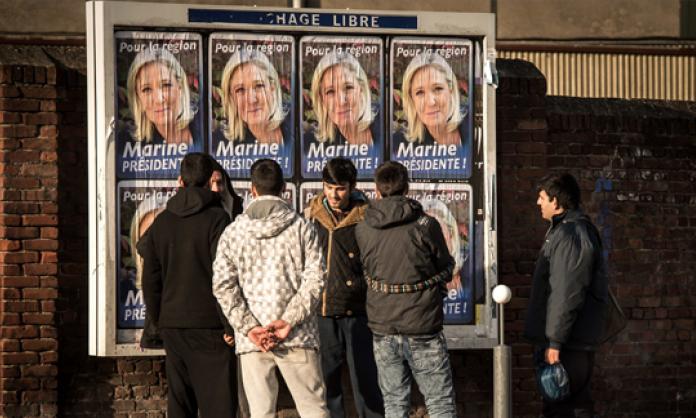The neo-fascist National Front (FN) gained first place in six of 13 regions in the first round of voting in France’s regional elections on 6 December.
Party leader Marine Le Pen won more than 40 percent of the vote in Nord-Pas-de-Calais-Picardie, the northern most region, bordering Belgium. In the town of Hénin-Beaumont, she took nearly 60 percent.
Florian Philippot, a party vice president, won 35 percent in neighbouring Alsace-Lorraine-Champagne-Ardenne. Le Pen’s niece, Marion Maréchal-Le Pen, won 42 percent of the vote in Provence-Alpes-Côte d’Azur, which takes in Marseille and Cannes on the Mediterranean coast.
The National Front also came first in Bourgogne-Franche-Comté, Centre-Val de Loire, and Languedoc-Roussillon-Midi-Pyrénées.
This is the fascists’ strongest result since the party’s foundation in 1972. The second round takes place on 13 December. It could be the first time that the FN takes control of a region. This would put it in a strong position going into the 2017 presidential elections.
Le Pen has likened the presence of Muslims in France to the Nazi occupation during World War Two. She said migrants are bearers of alien diseases, infiltrating French hospitals. The party wants to reintroduce the death penalty and create a “French first” system of welfare.
“France is no longer a State”, she said in a recent speech, because it has “become the vassal of other powers”. Her words are used to blur the class divide at the heart of French society and wedge apart the “French” and the “foreigner”. Ultimately, this is a discourse of race war:
“Sharia law will replace our constitution, women will have to wear the burqa, music will be banned, our buildings will be destroyed, other religions will be purged, barbarity will become the norm with all its horrors, as in all the countries where Muslim fundamentalists spread their influence.”
What explains the success of the National Front? The party surfed the recent wave of Islamophobia in the wake of the 13 November terrorist attacks, but there is more to it.
“Le Pen”, French Marxist Daniel Bensaïd once wrote, “is Dorian Gray’s portrait of the left disowned; the faithful mirror of its betrayals”.
The National Front’s rise has accompanied the demise of the traditional left since the years of François Mitterrand’s Socialist Presidency from 1981-95. Mitterrand’s election raised great hopes for a new era of left government. Soon, these hopes were dashed as he turned to neoliberalism in 1983.
The Communist Party, a party that had organised the most advanced and militant sections of the industrial labour movement, was weakened by its role as a junior partner in Mitterrand’s first government. Many others entered the administration under the Socialist Party’s rule.
The left experienced a moral and political degeneration.
The early 1990s also witnessed the collapse of the Stalinist regimes in Eastern Europe, marking the end of the “short twentieth century”, as historian Eric Hobsbawm put it. European revolutionary thinking had lost its bearings.
The Socialist Party and the Communist Party have continued to disown their left wing identity. Recent weeks have seen this degeneration accelerate, which played into the hands of Le Pen.
The question now is how much ground the far right can take, and how much more ground the left is prepared to cede.










